The journey started out simply enough. We were picked up at our hotel by an agent from the tour agency and delivered to their bus terminal. 7:30 p.m., the light starting to fade, and we pull out onto the highway, saying goodbye to Chiclayo (with regret, we really enjoyed ourselves there and so much more to do that we didn’t start on), heading eastward, inland, to the sierra amazonica, the hills of the Amazon basin. Our first destination, the small city of Chachapoyas, the “clouded mountain”, a mile and a half above sea level, and the capital of the Amazonas. It is dark quickly, and after a snack, and some vague screenings of partial movies on the bus’ teeny screens, we doze off. I awake some time later as the bus lurches from side to side, angled heading upwards at what seems like an impossible grade to be climbing in anything other than an all terrain vehicle. I peer out into the darkness through the curtain and can only vaguely make out that we are jouncing along a one lane dirt road, and no more than a meter or so to our right is a sheer drop-off. There is little I can do now, and panic would be useless, I have to assume that, in general, these folk know what they’re doing. I close the curtain and doze fitfully. We awaken as the bus pulls into town, 6 a.m. or so. We’re met by Rolando, who will be our local coordinator for the next three days, and he grabs our bags and we jump into a taxi.
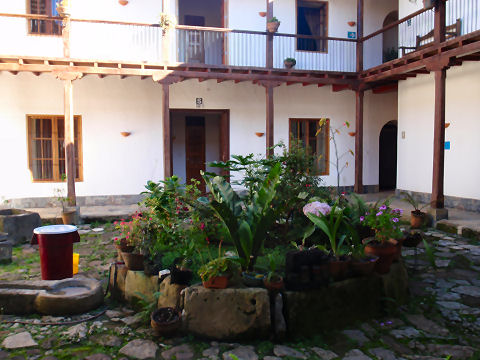
In a few short blocks we are at Casa Monsante, a beautiful converted Spanish style hacienda around a stunning courtyard garden – completely unexpected given the generally grey, dingy setting of the town – even the front of the hotel looks like nothing more than a semi-rundown older building. And, wouldn’t you know it, the water main has been cut off – during the course of putting in new waterlines, the town has uncovered a century-plus old stone water supply line buried underneath the street and is trying to decide what to do about it. They promise that water will be available later in the day, though it may be sporadic during our visit (thankfully, it wasn’t, it stayed on throughout the rest of our time there). We have no time for more than a quick nap before, at 8 a.m., Rolando returns to guide us to a van where we join a dozen others for an hour and a half cross-country ride to the entrance to the Gocta waterfall area. These falls were “discovered” only a few years ago in 2003 and only opened to the public recently, in 2006/7. Of course, they were known to the locals for centuries, but they didn’t want to talk about them as there is a local belief that the place is cursed by a blond mermaid. No one seems quite sure anymore what the curse was or why it was an issue to have outsiders visit.
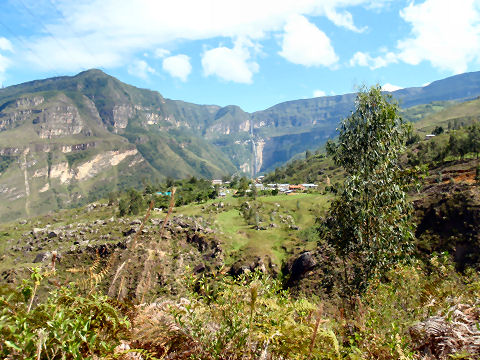
Now, I should note. I’m not a big waterfall fan. I just don’t get it. They’re pretty and all that, and sometimes even fairly impressive. But normally, I just can’t get myself all that interested to go see water falling off a cliff. But, this is part of the package, so I gamely face up to the five kilometer trek over an equal number of hills, rising and falling. I’d probably be better at this with some real sleep and some breakfast, but neither has happened. Looking out over the upcoming trail, I can’t say that I’m enthused.
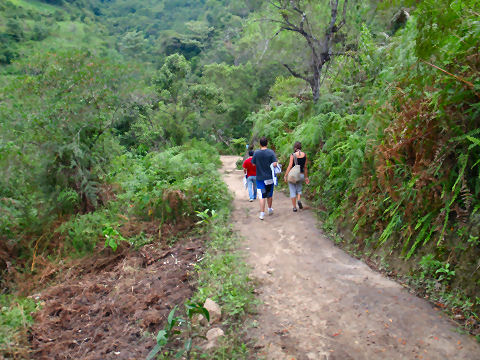
We start down the trail, some folks take off at a good clip, others dawdle along behind. There seems to be no group effort here, and the guide who we have with us isn’t overly forthcoming with information along the trail, seeming more interested in just bringing up the rear and making sure no one gets left behind. Occasionally, when asked, he responds to questions. Nice enough guy, just not very communicative, especially for a trail guide.
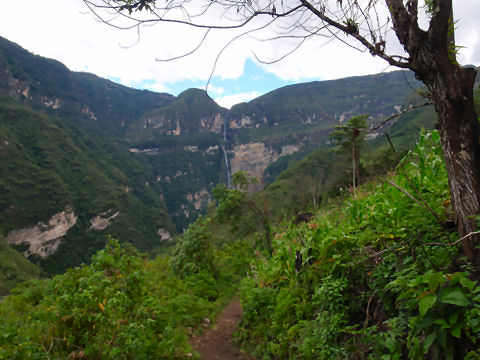
Awhile into the trek, up the second hill, we can glimpse the falls a bit closer. They don’t look all that impressive, and indeed, our guide concedes that this is the lowest water-flow time of year. But still, the draw for enthusiasts of the things, this is the third tallest waterfall in the world, coming in at roughly half a mile in height from the point the water originates to the pool below.
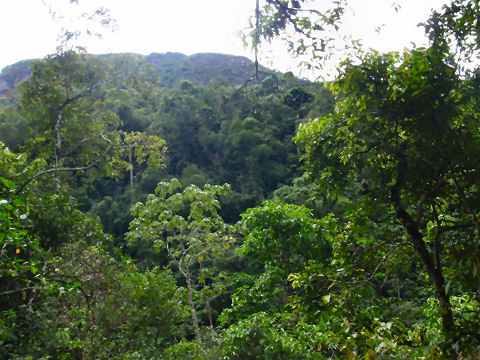
The one thing that begins to interest me is how unrelentingly green everything is. Intense too. And the butterflies – a whole slew of them in various colors – a separate post in itself to come. I find myself, if not particularly excited by the end goal of the rest of the group, at the very least fascinated by the natural beauty surrounding me. And without having had any coffee, either.
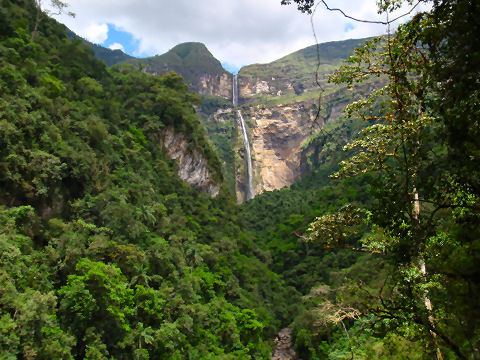
We move slowly, closer and closer. Each time we glimpse it it appears clearer and clearer, though still a ways off.
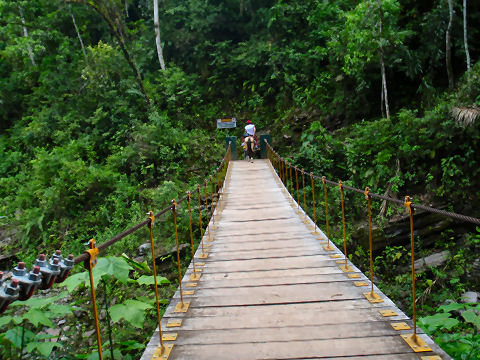
We cross suspended bridges over small creeks. Thankfully nothing that leaves us dangling in the air over any vast chasms.
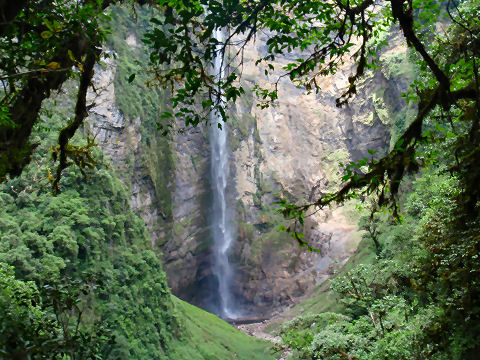
Finally the falls become clear and we seem to be nearing the trek’s end.
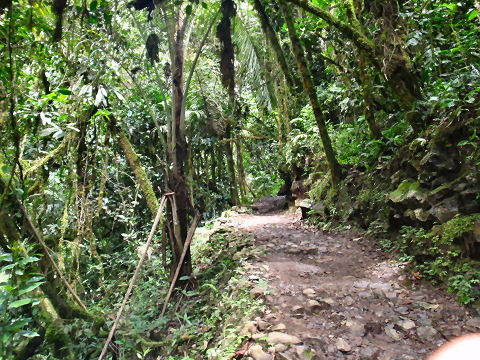
A slightly false hope it turns out, as we come around a bend and have yet one more hill to climb and descend…
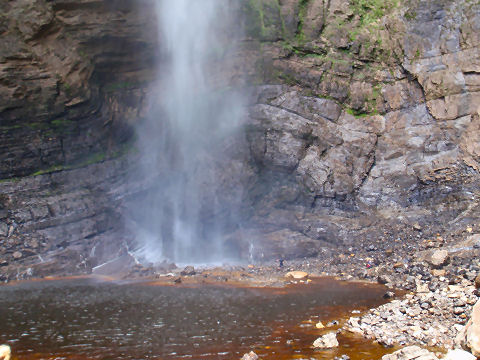
…and finally, arrive on a heap of rocks overlooking the deep pool into which the falls drop.
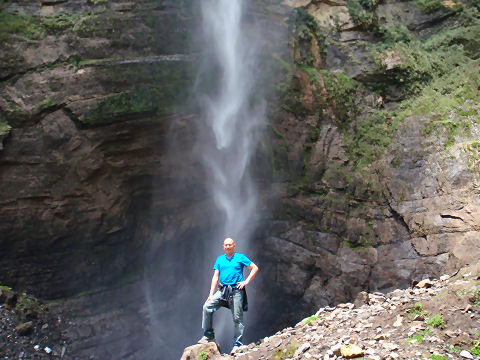
Henry is even able to persuade me to pose in front of them.
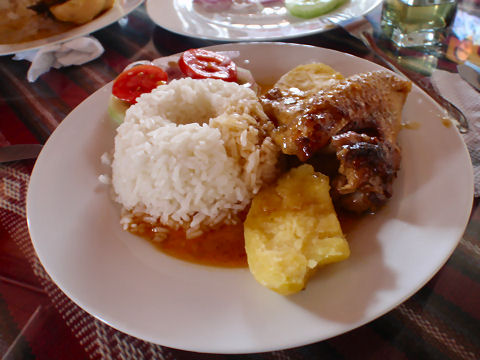
We spend about 45 minutes at the falls, clambering about the rocks, some folks even wading through the pool or around the edge to stand under them. I guess, from a sort of weird, macho standpoint, I can understand it (and they were virtually all guys doing this), but the idea of getting soaked by icy water falling from a half mile height onto my head just doesn’t really appeal. We snap lots of photos, take a couple of videos (soon to be posted on youtube, though there are numerous ones there already), and begin the 2½ hour walk back to the entrance, where a community of a dozen or so homes awaits, one of which operates as an in-home restaurant of sorts. I can’t tell you if the food was really good or if it was just that we were so tired and hungry by that point that it seemed that way, but we lunched upon herbal tea, vegetable soup, and a choice of entrees – mine a spicy turkey wing accompanied by rice, yuca, and salad (I don’t think I’ve ever eaten so much plain white rice and yuca sequentially as I did this trip, I’m not sure I really want to see either of them ever again). After eating, we rested a bit on the grassy plaza in the center of the pueblito, then climbed back into the van for an hour and a half ride back to the hotel where we were finally able to shower and rest a bit.
The big surprise, here in the middle of the high sierra, easy access to wi-fi. While our hotel didn’t have it, there were half a dozen unsecured connections available to us in range of our room, and virtually every cafe in the Plaza de Armas has it. Quite a change from Henry’s hometown of Trujillo, a “metropolis” of over 800,000 people, where outside of the few luxury hotels in town, there seems to be only one cafe in the entire city that has wi-fi. The idea of individuals having laptops that they carry around seems to be pretty much unheard of, and at that one cafe, DeMarco, in fact, they warned us each time we came in to guard things carefully as, being the only place where people came to use their laptops in the downtown area, they were regular targets of armed thieves. Oh joy. Part of why I didn’t do much posting from Trujillo and did it all from Chiclayo and Chachapoyas.